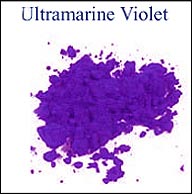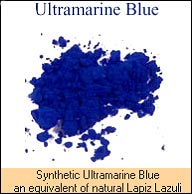
Home![]() Profile
Profile ![]() Product Range
Product Range![]() Industries
Industries![]() Infrastructure
Infrastructure![]() Our Quality
Our Quality![]() Custom Manufacturing
Custom Manufacturing![]() Network
Network![]() Contact Us
Contact Us![]() Send Enquiry
Send Enquiry
Dyestuffs| Inkjet Dyes | Dyes for Wax Printing | Textile Auxiliaries | Optical Brightner | Caramel Color | Synthetic Food Colors
Natural Food Colors| Pigments| Inorganic Pigments| Dyes Intermediates| Resist Salt| Klostrozal Dyes for Soap And Detergent



Colour Index | Dyes | Pigments | Applications | Glossary | FAQ's | Buyers Guide | Global Dyestuff Industry
![]()
| Range of Applications | What Ultramarine is used to color | Characteristics of Ultramarine that make it useful |
| Paints | Oil, water and acrylic paints; water-based emulsion paints, architectural coatings, floor paints, sealants. | Light fastness, heat resistance & non-migratory. But, in acidic atmosphere it can be decolorised. |
| Domestic Applications | Tooth paste, eyeliner, pencil & crayon, detergents, lipstick, food packaging & containers, children paints, mineral water bottles, toilet soaps. | These pigments are not toxic in nature. |
| Inks and coatings | Leather and paper coatings, coloring papers, printing inks, textile printing inks. | These pigments have shading and tinting effect like most of the other colorants. Ultramarine pigments can be mixed with other colorants to generate a wide range of colors. |
| Plastics & Fibers | Plastic pipes, thermoplastics, plastic film and containers, vinyl and linoleum floor coverings, natural and synthetic rubbers and synthetic fibers. | Ultramarine does not cause shrinkage, distortion or warping of polymers in which it is incorporated (it gives "dimensional stability"). |
| Ultramarine does not "leak" poisonous effluent in a landfill site in which the plastics or fibers are dumped. |
 Ultramarine
Violet Pigments are very safe at the time of their applications and
non-hazardous, non-toxic in nature. These pigments are used for a number of
applications as colorants. The main uses of these pigments are for printing
inks, paints, plastics and cosmetics. Ultramarine violet pigments are used
for artist's colors, industrial finishes, paper & plastics, decorative
paints and all kind of color corrections. These pigments are totally
non-bleeding, very high heat resistance and can be dispersed very easily.
Ultramarine
Violet Pigments are very safe at the time of their applications and
non-hazardous, non-toxic in nature. These pigments are used for a number of
applications as colorants. The main uses of these pigments are for printing
inks, paints, plastics and cosmetics. Ultramarine violet pigments are used
for artist's colors, industrial finishes, paper & plastics, decorative
paints and all kind of color corrections. These pigments are totally
non-bleeding, very high heat resistance and can be dispersed very easily.  Ultramarine
Blue are non-hazardous, safe blue color pigments. These pigments have wide
range of applications. Full control can be imposed on their synthetic
manufacturing process and close control can be kept over theirs physical,
chemical and color characteristics. This makes possible the wide range of
applications of these pigments. These pigments are used in manufacturers of
plastic, printing inks, cosmetic and many other industries. These blue
ultramarine pigments are also environment friendly.
Ultramarine
Blue are non-hazardous, safe blue color pigments. These pigments have wide
range of applications. Full control can be imposed on their synthetic
manufacturing process and close control can be kept over theirs physical,
chemical and color characteristics. This makes possible the wide range of
applications of these pigments. These pigments are used in manufacturers of
plastic, printing inks, cosmetic and many other industries. These blue
ultramarine pigments are also environment friendly.
Colour Index | Dyes | Pigments | Applications | Glossary | FAQ's | Buyers Guide | Global Dyestuff Industry
Home![]() Profile
Profile
![]() Product
Range
Product
Range![]() Industries
Industries![]() Infrastructure
Infrastructure![]() Our
Quality
Our
Quality![]() Custom
Manufacturing
Custom
Manufacturing![]() Network
Network![]() Contact
Us
Contact
Us![]() Send
Enquiry
Send
Enquiry